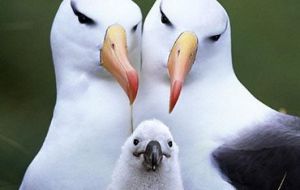MercoPress. South Atlantic News Agency
Fighting to get Atlantic albatrosses off the hook
 Black-browed albatross portrait
Black-browed albatross portrait As scientists gather in Recife, Brazil, to agree on quotas for the Atlantic and Mediterranean stocks of tuna and swordfish in the latest round of fisheries talks, the RSPB (Royal Society for the Protection of Birds) and BirdLife International are reminding delegates that at least 37 species of seabirds are at risk from these fisheries.
Indeed, 16 of these species, including albatrosses, are under threat of extinction. Getting caught in fishing gear is the greatest single threat that some of these seabirds face. Eight of the top ten seabird species considered to be most at risk from Atlantic longline fisheries nest on the three UK Overseas Territories in the South Atlantic: the Falkland Islands; Tristan da Cunha and South Georgia
The RSPB and BirdLife International hope that talks - organised by the International Commission for the Conservation of Atlantic Tunas (ICCAT) - will agree measures to prevent the deaths of these seabirds in the Mediterranean and Atlantic. In tuna and swordfish fisheries, albatrosses and other seabirds die on the end of longline hooks in unsustainable numbers and, for many species, this is their greatest extinction threat.
Dr Cleo Small - an albatross expert working with the RSPB and BirdLife International - is attending the Recife meeting to try to secure a better future for Atlantic seabirds, especially albatrosses.
Dr Cleo Small said: “The populations of albatrosses are declining faster in the South Atlantic than any other ocean. For example, the wandering albatross – possessing the largest wingspan of any bird – is rapidly declining on South Georgia, and links have been made between these declining populations and longline fishing within the ICCAT fishery. This situation is needless, because the technology exists to prevent these deaths.
“We will be urging delegates to approve rules that make it mandatory for all vessels fishing for tuna and swordfish in the Atlantic to abide by simple measures which lower the risk of albatrosses and other seabirds dying in these fisheries.”
Dr Small added: “The main problem is that albatrosses try to steal fish and squid bait from longline fishing hooks. The birds get caught on the hook and quickly drown when the lines are set. The bodies of these birds, recovered hours later, are a grim reminder of the sheer toll of seabirds that these fisheries can take.”
Monitoring of wandering albatrosses by the British Antarctic Survey on South Georgia has revealed a halving in the number in 2009 compared with the early 1960s.
Some of the most at risk species include the Tristan albatross of the South Atlantic and the Balearic shearwater of European waters. Both species, which are listed as Critically Endangered by BirdLife on behalf of the IUCN, are important to the UK. The Balearic shearwater, which nests on the Balearic Islands of the Mediterranean, is a regular non-breeding visitor to the waters off southern Britain, while the Tristan albatross is endemic to Gough Island, part of the UK Overseas Territory of Tristan da Cunha, and is found nowhere else in the world.
Eight of the top ten seabird species considered to be most at risk from Atlantic longline fisheries nest on the three UK Overseas Territories in the South Atlantic: the Falkland Islands; Tristan da Cunha and South Georgia. The top six most at risk seabird species in the Atlantic are albatrosses.
The RSPB is a Partner in BirdLife's Global Seabird Programme which works around the globe to conserve seabirds, and is striving to ensure that relevant international agreements are implemented that will benefit both the birds and the legal fishing industry.
The Programme also works hard to promote simple and inexpensive mitigation measures, which are highly successful in reducing seabird by-catch. The Programme achieves this through the Albatross Task Force (ATF) - the world’s first team of dedicated instructors to demonstrate the correct use of mitigation measures to fishermen, and to develop and test new measures. The ATF has instructors in seven countries, including South Africa, Namibia, Brazil, Uruguay and Argentina in the Atlantic. Chile and Ecuador also have ATF programmes.
“Dying at a rate of around one every five minutes, the albatross family is becoming threatened faster than any other family of birds”, added Dr Small. The Albatross Task Force began in 2006 and it’s already having huge success around the globe, but we need more help”
A variety of mitigation measures are available to prevent the deaths of albatrosses and other seabirds. One of the most popular is the tori, or streamer, line. Using this technique, fishing crews pay out lines of streamers from the stern of a vessel. Effectively, these streamers create a curtain, deterring albatrosses from coming too close to the danger zone, just off the stern of the vessel.
Mitigation measures have been used to great effect in some of the world’s other fisheries. In sub-Antarctic waters – operating in the CCAMLR fisheries region – mitigation measures have reduced albatross by-catch from thousands of birds a year to effectively zero. Additionally, fantastic reductions in seabird by-catch have been secured within the foreign tuna longline fleet, operating in South African waters.
Since 2006, this fishery has cut seabird by-catch by 85%. (RSPB)-




Top Comments
Disclaimer & comment rulesCommenting for this story is now closed.
If you have a Facebook account, become a fan and comment on our Facebook Page!